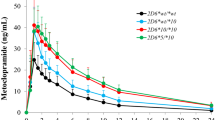Summary
The intrinsic clearance of unbound drug (CLuint) for antipyrine in 15 mammalian species was characterized by an equation of the form, CLuint=ϕ1 (body weight)ϕ 2 (brain weight)ϕ 3, where thetas are constants. Maximum lifespan potential in mammals can also be characterized by an equation of this form. It is suggested that the set of genetic mechanisms regulating longevity and other constitutional characteristics in species is also linked to rates of drug metabolism. The ability to scale interspecies data in pharmacokinetics is taken as an expression of this design principle.
Similar content being viewed by others
References
Kuhn, T.S. (1977). Second thoughts on paradigms. In “The Structure of Scientific Theories,” (F. Suppe, ed.) University of Illinois Press, Urbana, pp. 459–517.
Hart, R.W. and Turturro, A. (1983): Species longevity as an indicator for extrapolation of toxicity data among placental mammals. J. Am. Coll. Toxicol. 2: 235–243.
Ashby, W.R. (1960). “Design for a Brain: The Origin of Adaptive Behavior,” 2 nd ed., Chapman and Hall Ltd., London, p. 12.
Toulmin, S. (1953). “The Philosophy of Science: An Introduction”, Hutchinson, London, p. 44.
Toulman, S. (1961). “Foresight and Understanding,” Hutchinson, London, p. 115.
Suppe, F. (1977). The search for philosophic understanding of scientific theories. In “The Structure of Scientific Theories,” 2nd ed., (F. Suppe, ed.), University of Illinois Press, Urbanna, pp. 3–243.
Fethe, H. (1982). Models’ limits suggest reflexivity in nature. Am. J. Physiol.242: R167-R171.
Georgescu-Roegen, N. (1971): “The Entropy Law and the Economic Process,” Harvard University Press, Cambridge.
Boxenbaum, H. (1983): Evolutionary biology, animal behavior, fourth-dimensional space, and the raison d’être of drug metabolism and pharmacokinetics. Drug Metab. Rev.14: 1057–1097.
Miller, J.G. (1978): “Living Systems,” McGraw-Hill, N.Y., pp. 35–36.
Sacher, G.A. (1965): On longevity regarded as an organized behavior: The role of brain structure. In “Contributions to the Psychobiology of Aging,” (R. Kastenbaum, ed.), Springer, N.Y., Chapter 9, pp. 99–110.
Gould, S.J. (1966): Allometry and size in ontogeny and phylogeny. Biol. Rev.41: 587–640.
Boxenbaum, H. (1980): Interspecies variation in liver weight, hepatic blood flow, and antipyrine intrinsic clearance: Extrapolation of data to benzodiazepines and phenytoin J. Pharmacokin. Biopharm.8: 165–176.
Wilkinson, G.R. and Shand, D.G. (1975): A physiological approach to hepatic drug clearance. Clin. Pharmacol. Therap.18: 377–390.
Pang, K.S. and Rowland, M. (1977): Hepatic clearance of drugs. I. Theoretical considerations of a “well-stirred” model and a “parallel tube” model. Influence of hepatic blood flow, plasma and blood cell binding, and the hepatocellular enzymatic activity on hepatic drug clearance J. Pharmacokin. Biopharm.5: 625–653.
Rowland, M. (1972). Influence of route of administration on drug availability J. Pharm. Sei.61: 70–74.
Boxenbaum, H. (1982): Interspecies scaling, allometry, physiological time, and the ground plan of pharmacokinetics. J. Pharmacokin. Biopharm.10: 201–227.
Sacher, G.A. and Staffeldt, E.F. (1974): Relation of gestation time to brain weight for placental mammals: Implications for the theory of vertebrate growth. American Naturalist.108: 593–615.
Jerison, H.J. (1973). “Evolution of the Brain and Intelligence,” Academic Press, N.Y., pp. 392–393.
Altman, P.L. and Dittmer, D.S. (1962). “Growth, including Reproduction and Morphological Development,” Federation of American Societies for Experimental Biology, Wash. D.C., p. 357.
Dawson, T.J. (1973): “Primative” mammals. In “Comparative Physiology of Thermoregulation. Special Aspects of Thermoregulation. ” Vol. III, (G.C. Whittow (ed.), Academic Press, N.Y., Chapter 1, pp. 1–46.
Spector, W.S. (ed.). (1956). “Handbook of Biological Data,” W.B. Saunders Co., Phila., p. 343.
Altman, P.L. and Dittmer, D.S. (eds.). (1971). “Respiration and Circulation”, Federation of American Societies for Experimental Biology, Bethesda, p. 225.
Whittow, G.C. (1971). Ungulates. In “Comparative Physiology of Thermoregulation. Mammals,” vol. II, (G.C. Whittow, (ed.), Academic Press, N.Y., Chapter 3, pp. 191–281.
Hart, J.S. (1971). Rodents. In “Comparative Physiology of Thermoregulation. Mammals,” vol. II, (G.C. Whittow, (ed.), Academic Press, N.Y., Chapter 1, pp. 1–149.
Altman, P.L. and Dittmer, D.S. (eds.). (1973): “Biology Data Book”, vol. II, 2nd ed., Federation of American Societies for Experimental Biology, Bethesda, p. 863.
Swan, H. (1974): “Thermoregulation and Bioenergetics: Patterns for Vertebrate Survival,” American Elsevier Pub. Co., N.Y., p. 330.
Ray, A.A. (ed.). (1982): “SAS User’s Guide: Statistics” SAS Intitute Inc., Cary, North Carolina.
Cohen, J. and Cohen, P. (1975): “Applied Multiple Regression Correlation: Analysis for the Behavioral Sciences,” Lawrence Erlbaum Associates, Hillsdale, N.J. pp. 106–107.
Sacher, G.A. (1959): Relationship of lifespan to brain weight and body weight in mammals. In “The Lifespan of Animals,” Ciba Foundation Colloquia on Ageing, vol. 5, (G.E.W. Wolstenholme and M. O’Connor, (eds.), Little Brown and Co., Boston, pp. 115–141.
Sacher, G.A. (1978): Longevity and aging in vertebrate evolution. Bioscience.28: 497–501.
Sacher, G. A. (1978): Evolution of longevity and survival characteristics in mammals. In “Genetics of Ageing”, (E.L. Schneider, ed.), Plenum Press, N.Y., Chapter 6, pp. 151–168.
Williams, G.C. (1957): Pleiotropy, natural selection, and the evolution of senescence. Evolution.11: 398–411.
Sacher, G.A. (1966): Abnutzstheorie. In “Perspectives in Experimental Gerontology,” (N.W. Shock, ed.), Charles C. Thomas, Springfield, Ill., pp. 326–335.
Boxenbaum, H., Murray, W., Markin, R. and Ciraulo, D. (1984): Benzodiazepine pharmacokinetics: Clinical highlights and interspecies scaling. In Pharmacokinetics and Pharmacodynamics of Psychoactive Drugs (G. Barnett and N. Chiang, eds.), Marcel Dekker, Inc., N.Y., In press.
Boxenbaum, H. and Ronfeld, R. (1983): Interspecies pharmacokinetic scaling and the Dedrick plots Am. J. Physiol245: R768-R775.
Author information
Authors and Affiliations
Rights and permissions
About this article
Cite this article
Boxenbaum, H., Fertig, J.B. Scaling of antipyrine intrinsic clearance of unbound drug in 15 mammalian species. European Journal of Drug Metabolism and Pharmacokinetics 9, 177–183 (1984). https://doi.org/10.1007/BF03189622
Received:
Issue Date:
DOI: https://doi.org/10.1007/BF03189622




